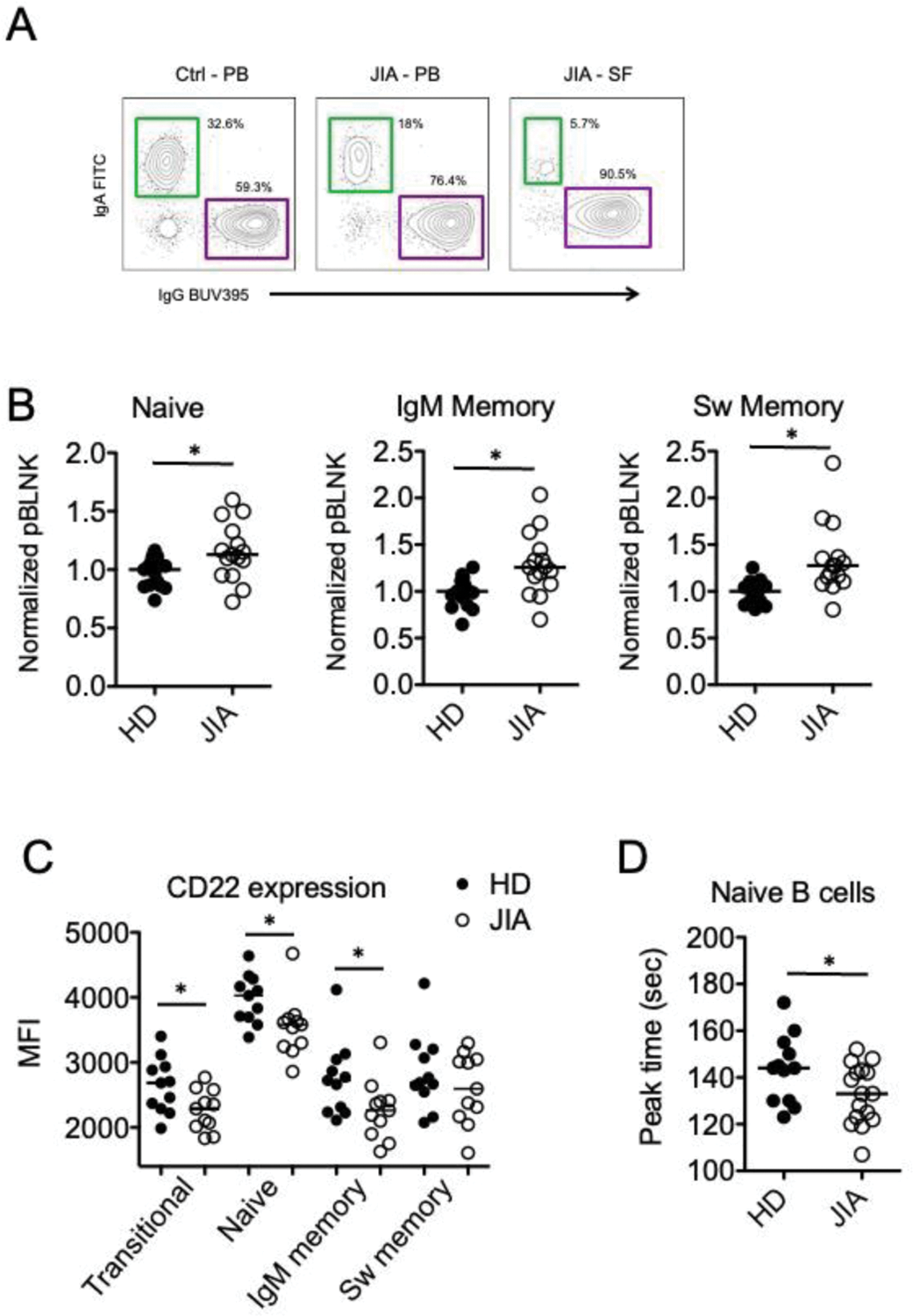

Background: Juvenile Idiopathic Arthritis (JIA) is the most common form of chronic arthritis in childhood. The adaptive branch of the immune system plays a crucial role in the development of JIA. We have showed that switched memory B cells are expanded in patients with oligoarticular- and polyarticular-JIA.
Objectives: The aim of this study is to investigate abnormalities in the switched memory B cell compartment and characterize the receptor signaling machinery in B cells of patients with oligo- and poly-JIA.
Methods: We enrolled patients with a diagnosis of oligoarticular and polyarticular JIA (n=15) and age matched controls (n=15). Surface staining of lymphocytes was carried out to identify B cell and T cell subsets in peripheral blood (PB) and synovial fluid (SF). Immunoglobulins levels were retrieved from electornic records. Intracellular levels of phospho-proteins were evaluated in PB by flow cytometry. PBMC were stimulated in vitro with an anti-Ig and stained for intracellular phospho-proteins. Calcium mobilization after anti-Ig stimulation was evaluated with Indo-1 by flow cytometry.
Results: The ratio of IgG to IgA switched memory B cells was higher in JIA patients than controls, indicating and expansion of IgG+ memory B cells over mucosal IgA+ memory B cells in JIA (Figure 1A). IgG+ memory B cells were the most abundant B cell subset in SF (Figure 1A). Serum levels of IgG, but not IgA, were higher in JIA patients than controls.
To investigate if the hyperactivation of B cells is due to an henanced B cell receptor (BCR) signaling, we analyzed the basal phosphorylation levels of 3 key enzymes (Syk, BLNK, ERK1/2) in B cells of JIA patients. We observed a higher frequency of phosphorylation of BLNK, but not of Syk and ERK1/2 in both naïve and memory B cells compared to controls (Figure 1B). Next, we evaluated the surface expression of CD22, a negative regulator of B cell signaling in all B cell subsets. Transitional, naïve and IgM memory B cells of patients with JIA showed reduced levels of CD22 compared to controls; no significant differences were observed in switched memory B cells (Figure 1C). As BLNK and CD22 regulate the calcium mobilization following BCR stimulation, we analyzed calcium mobilization. Upon in vitro stimulation of BCR, we observed that naïve B cells of patients with JIA had a faster calcium response to BCR activation, with a shorter peak time compared to controls (Figure 1D).
Conclusion: Our data confirm the expansion of IgG memory B cells and the hyperproduction of IgG in patients with JIA. We also show that naïve B cells of JIA patients exhibit a reduced expression of CD22 and an increased basal phosphorylation of BLNK. Upon activation of BCR, naïve B cells respond more promptly to BCR activation with faster calcium mobilization.

REFERENCES: NIL.
Acknowledgements: NIL.
Disclosure of Interests: Emiliano Marasco: None declared, Angela Aquilani: None declared, Matteo Trevisan: None declared, Ivan Caiello: None declared, Giusyda Tarantino: None declared, Rebecca Nicolai: None declared, Silvia Magni-Manzoni: None declared, Rita Carsetti: None declared, Fabrizio De Benedetti Novartis, SOBI